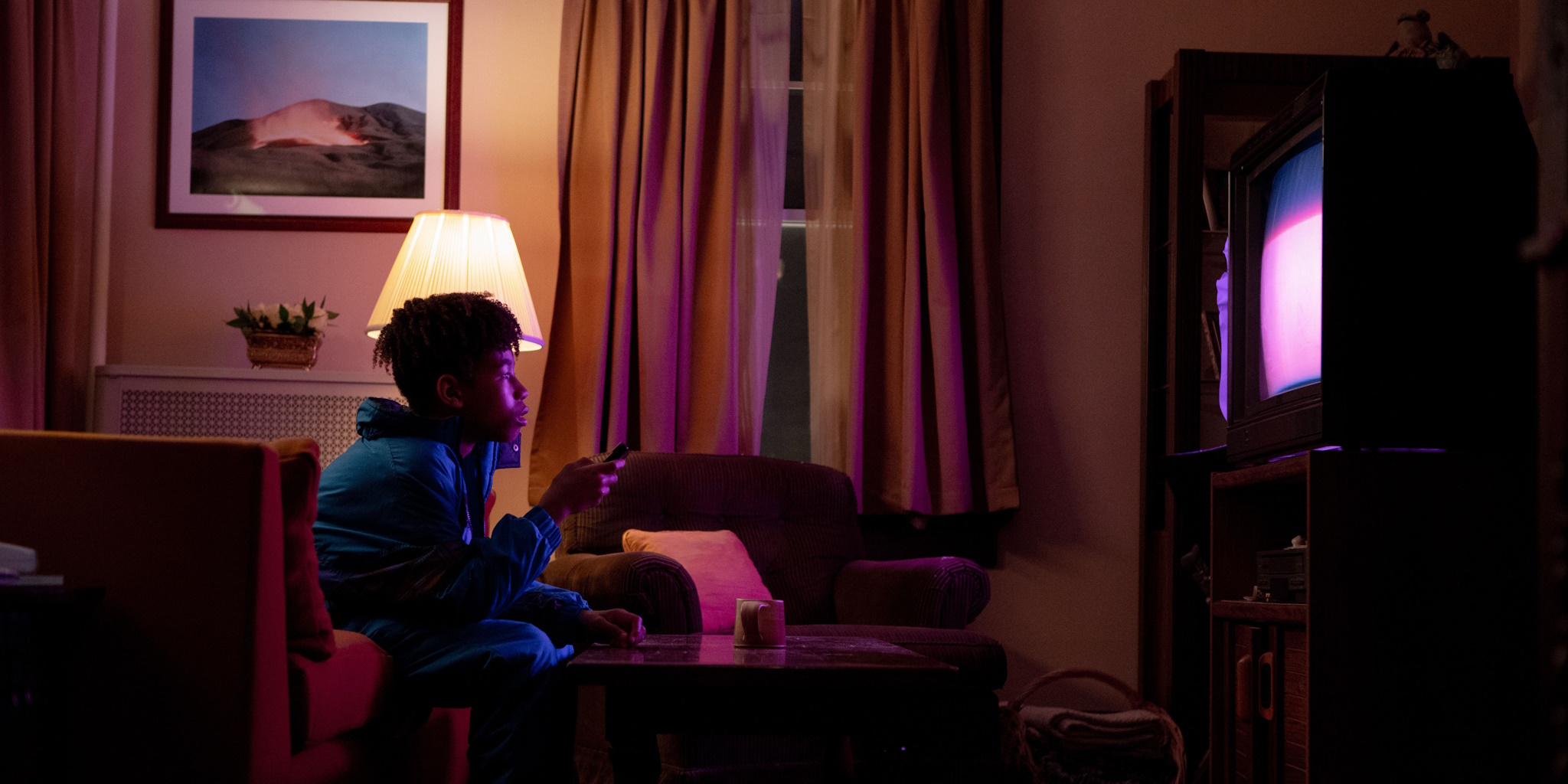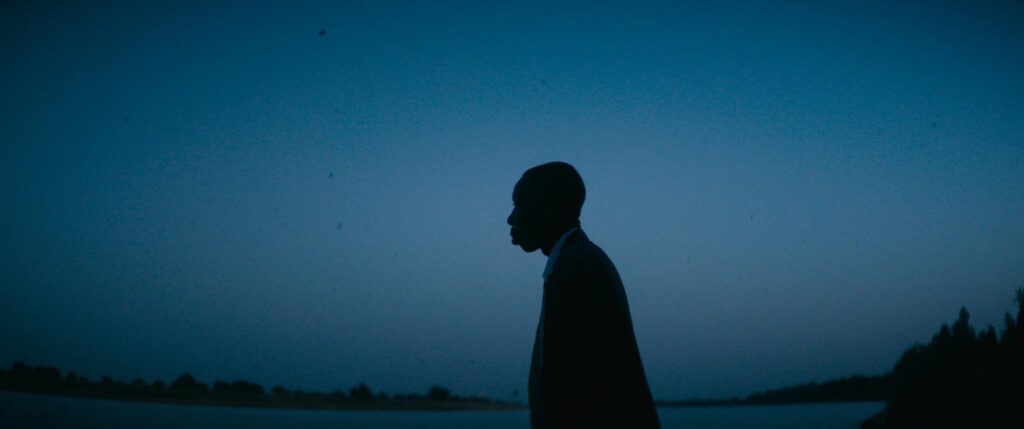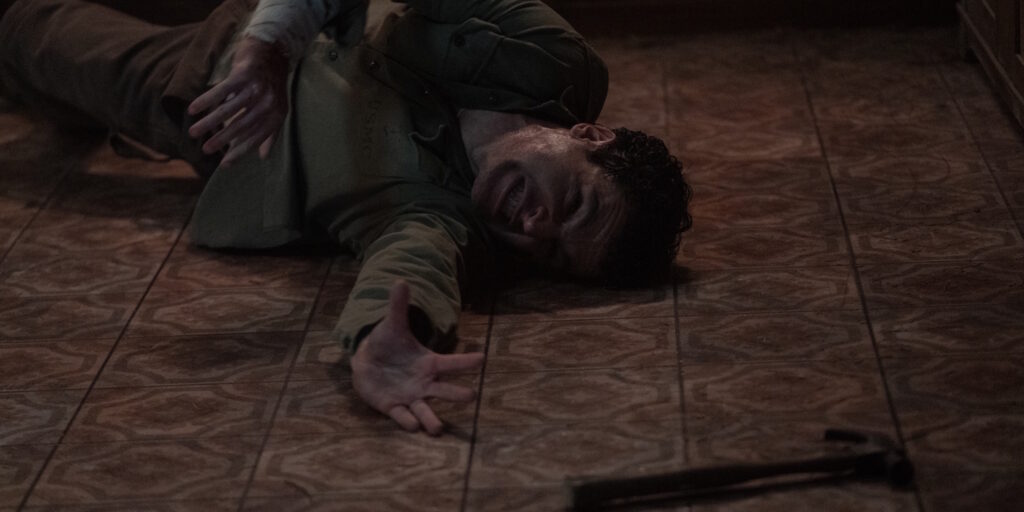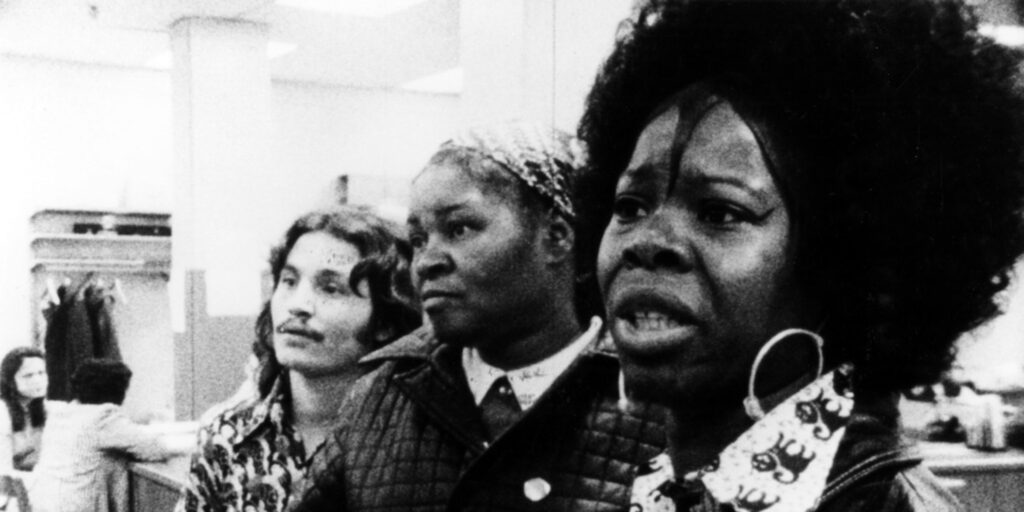It’s been three years since Jane Schoenbrun punched a reality-warping hole in the indie cinema scene with their skin-crawling fable of online paranoia and dissociation, We’re All Going to the World’s Fair. As microbudget directorial breakouts go, that film was a critical smash, solidifying Schoenbrun’s reputation as one of America’s most vital rising filmmakers. Yet World’s Fair felt more like a bracing proof-of-concept than a complete, coherent vision. Its inimitable aesthetic texture and compelling psychological portraiture – the film remains singular in its depiction of the addictive feedback loop of fringe online subcultures – were undercut by conceptual vagueness and occasionally frustrating narrative choices. Ultimately, this writer’s most enduring impression of the film was one of anticipation: World’s Fair whetted the appetite for where Schoenbrun would go next.
In contrast to the perpetually online, Gen Z milieu of their prior feature, Schoenbrun’s latest film, I Saw the TV Glow, unfolds primarily in their own formative millennial stomping grounds, a vivid, eerie suburban wasteland during the final exhale of the analog era. It’s a landscape familiar enough to ping the memory center of many a ’90s kid, but sufficiently uncanny to resemble an alternate reality created by the distorting lens of nostalgia. That haunting half-degree of skewness is, it turns out, essential to I Saw the TV Glow, a gnawing, gobsmacking marvel of a film about the wildfire magic of memory and fiction. Invigorating, mesmerizing, and confounding in equal measure, Schoenbrun’s latest delivers on the promise of World’s Fair and then some. Restlessly surreal and studded with jarring time skips, it’s the sort of defiantly alienating movie that seems designed to frustrate even its adoring obsessives. (See: Lynch, David.) It also feels like one of the most essential American films of the year.
The Orphic hero of this tale is a withdrawn kid named Owen (Ian Foreman), whom the viewer first meets when he is in the seventh grade in the autumn of 1996. An only child, he lives in a featureless New Jersey suburb with his devoted but strict Black mother (Danielle Deadwyler) and distant, abusive white father (Limp Bizkit frontman Fred Durst). Shy, sheltered, and apparently friendless, Owen is just beginning to emerge from behind his mother’s proverbial skirts. Through sheer happenstance, he meets ninth grader Maddy (Atypical’s Brigette Lundy-Paine), a slump-shouldered emo girl with her nose buried in an episode guide for the young-adult supernatural show The Pink Opaque. Though forbidden from watching such late-night fare, Owen’s interest has long been piqued by the series’ commercials, which is sufficient prompting for a super-fan like Maddy to strike up a conversation.
Freshly emboldened by this interaction, Owen uses the pretense of a sleepover at a classmate’s house to sneak over to Maddy’s on Saturday night, where they watch the latest episode of The Pink Opaque in hushed wonder. Blending the tween-friendly tone of SNICK fixtures like The Adventures of Pete and Pete and Are You Afraid of the Dark? with the edgier horror elements of Buffy the Vampire Slayer, the show-within-the-film centers on teen heroes Isabel (Helena Howard) and Tara (Lindsey Jordan), a pair of psychically bonded long-distance friends who use their powers to battle a rogue’s gallery of occult bogeymen. Owen is immediately hooked on the series’ earnest teen drama and intricate mythology, but his parents’ draconian control over his viewing habits ensure that this first taste of The Pink Opaque will be his last for some time.
Two years later, Owen (Justice Smith) has experienced a growth spurt, yet he seems more timid and self-conscious than ever. He nonetheless summons the courage to once again approach Maddy, who is seething over her recent ostracization by homophobic former friends. She agrees to loan him her bootlegged videotapes and handwritten notes on The Pink Opaque, catching him up on five seasons of missed episodes. For a time, this pop-cultural exchange becomes a kind of secret, shared correspondence for the unlikely pair, a sprawling saga written in grainy VHS and pink gel pen, successfully distracting Owen from his mother’s terminal illness and Maddy from her own miserable home life. However, Maddy’s rage-fueled discontent is approaching a breaking point, and she vacillates between mania and depression, muddling the fiction of The Pink Opaque and the violent, oppressive reality that she longs to flee. What remains unclear is whether Owen – who is equally unhappy, but much less certain of himself – will join her when she inevitably makes her escape.
On paper, there’s an indie-drama familiarity to the first half of I Saw the TV Glow, as Schoenbrun’s outcasts bond over their shared obsession with a mildly geeky, queer-coded work of pop entertainment. (Owen’s taciturn father at one point growls, “Isn’t that show for girls?” in a way that conveys both accusation and threat.) It’s debatable whether Owen and Maddy could precisely articulate why The Pink Opaque has burrowed so deeply into their young minds, but the allure of the series is powerful precisely because of its ineffability. It speaks to something inside these kids that is equally inexpressible, the ache of confused identity, meaning, and worth. “Do you like girls? Boys?” Maddy asks Owen at one point, squinting suspiciously at his intentions. “I like TV shows,” he shrugs, a response that might point toward asexuality or neurodivergence, but more broadly implies the pointlessness of labels when young people are still figuring themselves out.
I Saw the TV Glow offers a woozily potent evocation of a specific time and place, but like all the best works of remembrance, its power rests less on objective fidelity than on a subjective twinge of emotional and sensory recognition. Much as Sofia Coppola’s The Virgin Suicides (1999) conjures the atmosphere of a faded 1970s Polaroid – as opposed to a period-accurate facsimile of the 1970s – Schoenbrun’s feature feels like a vivid, ominous dream of 1990s suburbia. The time-machine details realized by production designer Brandon Tonner-Connolly are on point, to be sure, but I Saw the TV Glow emphatically recalls this era as one of stifling loneliness and gathering darkness, not Nickelodeon innocence. The film eschews full sunlight, draping even its daylight scenes in overcast gloom or pastel-streaked twilight haze. Interior spaces are stifling and windowless, except when they are bathed in the cold fire of television phosphors. Cinematographer Eric Yue suffuses the director’s stunning widescreen compositions with hyper-real luminescence in shades of blue, green, and orange. At times, the film’s lighting almost seems ultra-violet, cloaking some details in a navy-black murk and outlining others in fluorescent pink.
Eventually, I Saw the TV Glow leaps forward again to 2007, as a palpably dejected twenty-something Owen works a movie-theater job to support his now-widowed deadbeat father. Owen has not seen Maddy in more than a decade, as she inexplicably vanished around the same time that his mother died and The Pink Opaque was abruptly canceled. To Owen’s shock, Maddy suddenly reappears in the produce aisle of the local grocery store, looking just as wiry and intense as the girl he remembers. Over drinks at a local roadhouse, she answers his prying questions with a query of her own, “Do you remember a TV show we used to watch together?” Owen is perplexed, because of course he remembers. “Are you sure that’s all it was?” Maddy asks slowly and seriously, the question hanging ripe in the air, swollen with an indefinite terror. What exactly is Maddy trying to say? At this point, canny viewers may have already clocked that the name of the roadhouse is the same as the venue featured each week on The Pink Opaque. The musically inclined may have also noticed that real-world singer-songwriter Phoebe Bridgers is currently playing on stage with post-punk act Sloppy Jane – a band that wasn’t even formed until 2009. What the hell is happening? What year is this?
Schoenbrun has been candid about the outsize influence of Twin Peaks on I Saw the TV Glow, and in particular the importance of the show’s galvanic 25-years-later third season. Twin Peaks: The Return is, among many things, a TV show about revisiting a TV show, and while Schoenbrun is similarly fascinated with the act of watching, they don’t necessarily share David Lynch and Mark Frost’s sharp-elbowed skepticism toward media and technology. In I Saw the TV Glow, a silly program about psychic teens fighting monsters can become an accidental life preserver for a person lost at sea. Without cynicism or condescension, the film depicts how fandom can be a nourishing outlet for marginalized individuals who feel isolated, unseen, and excluded from more conventional interests and pursuits. It’s not incidental that the recurring Big Bad in The Pink Opaque is a lunar-faced villain whose design recalls Georges Méliès’ “A Trip to the Moon” (1902), given that people have been finding intensely personal meaning in moving images since the medium was invented. (The archvillain’s name, as it happens, is Mr. Melancholy, and he is behind all the terrors that the show’s heroines confront. Subtle, The Pink Opaque is not.)
Which isn’t to say that Schoenbrun is blind to the dark side of fandom, or to the ways in which memory and fantasy can become gilded prisons in their own right. Much as in Kumiko the Treasure Hunter (2014) and Under the Silver Lake (2018), I Saw the TV Glow illustrates that passions can easily become obsessions, and obsessions can eventually become truth-twisting, life-destroying pathologies. Schoenbrun’s feature is comfortable with the multidimensional pleasures and perils of pop-cultural consumption, just as it is content with the exhilarating uncertainty of its characters’ reality. Does The Pink Opaque hint at a hidden truth beneath the oppressively mundane surface of Owen’s life, or is Maddy just a delusional psychotic? A different kind of film would treat this question with slippery coyness, but I Saw the TV Glow approaches it with an intoxicating nerve. In a bravura monologue that Schoenbrun shoots in one long, ferocious, throat-tightening take, Maddy recounts the story of her own reality-shattering epiphany, while constellations thrown by an astronomy-class projector spiral overhead. Owen, for his part, is baffled and frightened by this display, unsure if the glint in his friend’s eye signifies enlightenment or madness.
I Saw the TV Glow teases the possibility of a Matrix-level paradigmatic upheaval in its second half, but Schoenbrun’s dreamlike, melancholic sensibility proves closer to Charlie Kaufman than to the Wachowskis. The film’s final stretch is arguably its darkest and most surreal – which is saying something in a movie that elsewhere features an ice-cream monster, dancing moon-people, and psychedelic portal-screens that look like gateways to the Lisa Frank version of Videodrome. Schoenbrun leaves much to the audience’s interpretation, which will doubtlessly be part of the appeal for viewers who walk away transfixed by the film’s flickering magic. It invites them to return again and again, as if to an esoteric dream they can’t resist untangling – or to a television show they never tire of binging.
I Saw the TV Glow opens in select local theaters on Friday, May 17.




